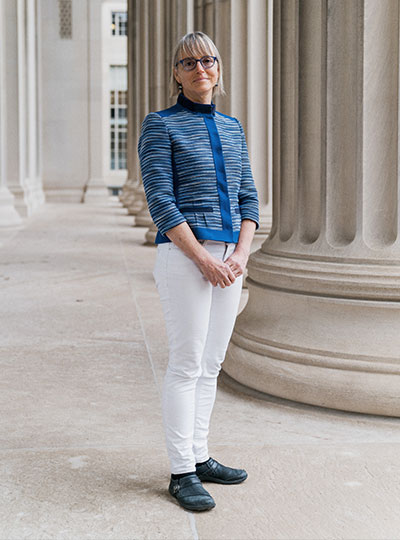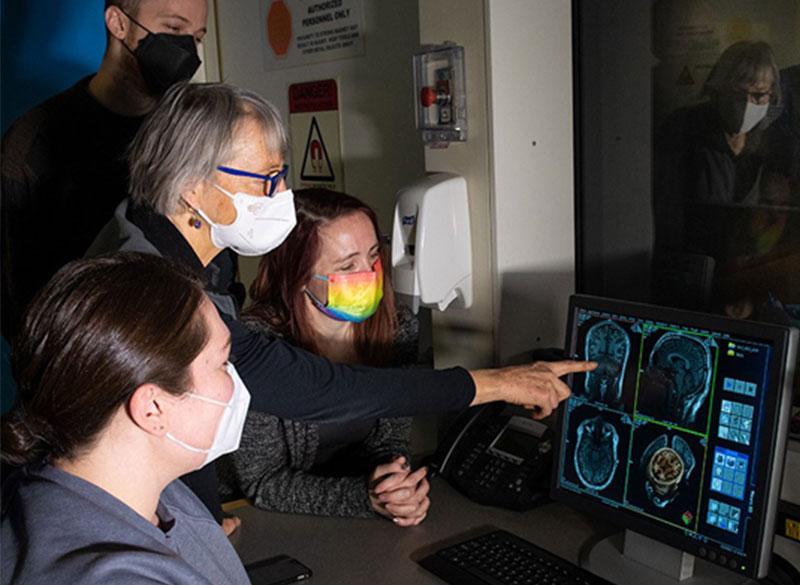MIT cell biologist Lindsay Case and computational neuroscientist Guangyu Robert Yang have been named 2022 Searle Scholars, an award given annually to 15 outstanding U.S. assistant professors who have high potential for ongoing innovative research contributions in medicine, chemistry, or the biological sciences.
Case is an assistant professor of biology, while Yang is an assistant professor of brain and cognitive sciences and electrical engineering and computer science, and an associate investigator at the McGovern Institute for Brain Research. They will each receive $300,000 in flexible funding to support their high-risk, high-reward work over the next three years.
Lindsay Case
Case arrived at MIT in 2021, after completing a postdoc at the University of Texas Southwestern Medical Center in the lab of Michael Rosen. Prior to that, she earned her PhD from the University of North Carolina at Chapel Hill, working in the lab of Clare Waterman at the National Heart Lung and Blood Institute.
Situated in MIT’s Building 68, Case’s lab studies how molecules within cells organize themselves, and how such organization begets cellular function. Oftentimes, molecules will assemble at the cell’s plasma membrane — a complex signaling platform where hundreds of receptors sense information from outside the cell and initiate cellular changes in response. Through her experiments, Case has found that molecules at the plasma membrane can undergo a process known as phase separation, condensing to form liquid-like droplets.
As a Searle Scholar, Case is investigating the role that phase separation plays in regulating a specific class of signaling molecules called kinases. Her team will take a multidisciplinary approach to probe what happens when kinases phase separate into signaling clusters, and what cellular changes occur as a result. Because phase separation is emerging as a promising new target for small molecule therapies, this work will help identify kinases that are strong candidates for new therapeutic interventions to treat diseases such as cancer.
“I am honored to be recognized by the Searle Scholars Program, and thrilled to join such an incredible community of scientists,” Case says. “This support will enable my group to broaden our research efforts and take our preliminary findings in exciting new directions. I look forward to better understanding how phase separation impacts cellular function.”
Guangyu Robert Yang
Before coming to MIT in 2021, Yang trained in physics at Peking University, obtained a PhD in computational neuroscience at New York University with Xiao-Jing Wang, and further trained as a postdoc at the Center for Theoretical Neuroscience of Columbia University, as an intern at Google Brain, and as a junior fellow at the Simons Society of Fellows.
His research team at MIT, the MetaConscious Group, develops models of mental functions by incorporating multiple interacting modules. They are designing pipelines to process and compare large-scale experimental datasets that span modalities ranging from behavioral data to neural activity data to molecular data. These datasets are then be integrated to train individual computational modules based on the experimental tasks that were evaluated such as vision, memory, or movement.
Ultimately, Yang seeks to combine these modules into a “network of networks” that models higher-level brain functions such as the ability to flexibly and rapidly learn a variety of tasks. Such integrative models are rare because, until recently, it was not possible to acquire data that spans modalities and brain regions in real time as animals perform tasks. The time is finally right for integrative network models. Computational models that incorporate such multisystem, multilevel datasets will allow scientists to make new predictions about the neural basis of cognition and open a window to a mathematical understanding the mind.
“This is a new research direction for me, and I think for the field too. It comes with many exciting opportunities as well as challenges. Having this recognition from the Searle Scholars program really gives me extra courage to take on the uncertainties and challenges,” says Yang.
Since 1981, 647 scientists have been named Searle Scholars. Including this year, the program has awarded more than $147 million. Eighty-five Searle Scholars have been inducted into the National Academy of Sciences. Twenty scholars have been recognized with a MacArthur Fellowship, known as the “genius grant,” and two Searle Scholars have been awarded the Nobel Prize in Chemistry. The Searle Scholars Program is funded through the Searle Funds at The Chicago Community Trust and administered by Kinship Foundation.




